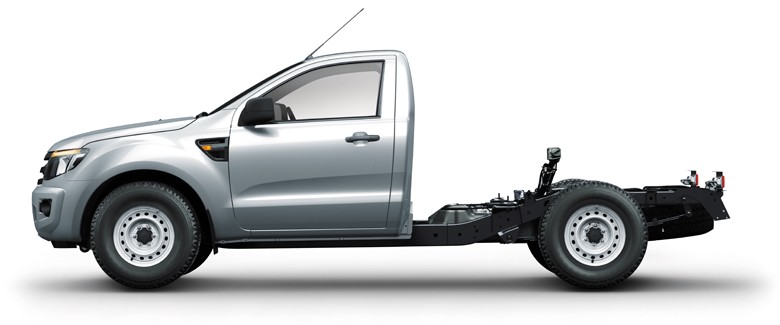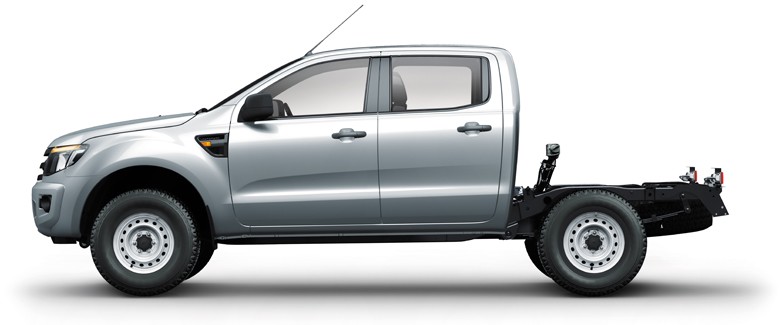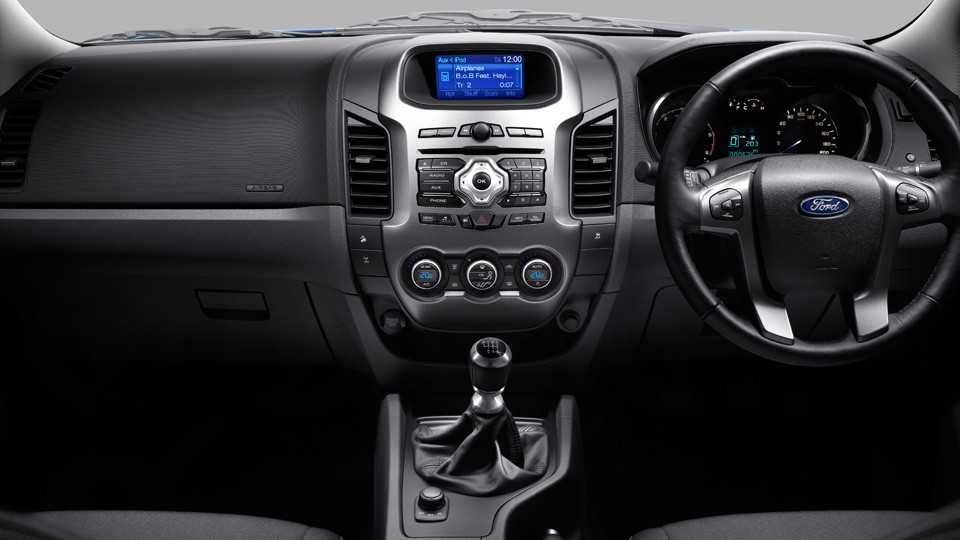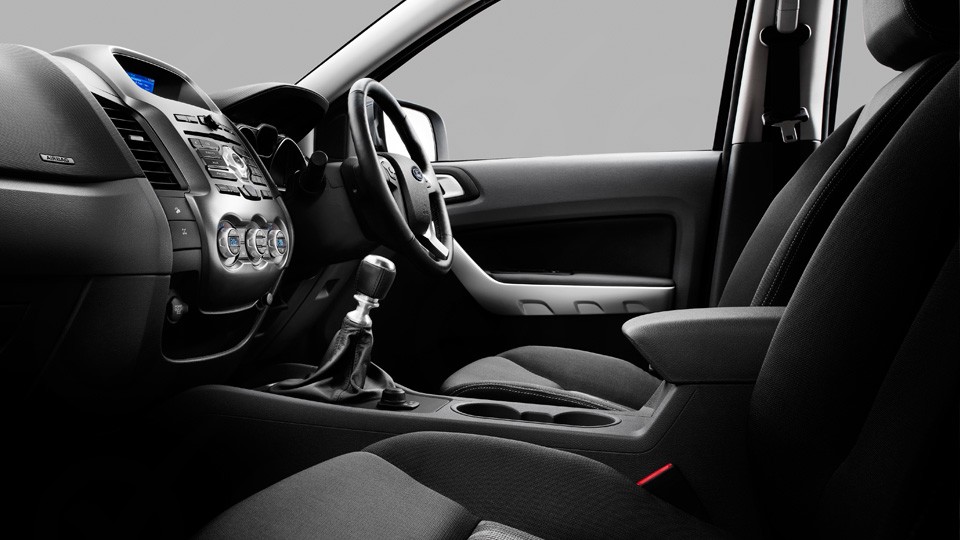
- Powerful 3.2-litre turbo-diesel engine
- Impressive ride/handling balance
- Supportive front seats
- High braked towing capacity
- Manual transmission has notchy action and high clutch take-up
- Steering wheel lacks reach adjustment
- Front seats lack lateral support
Review: Ford PX.I Ranger cab chassis (2011-15)
Overview
Released in October 2011, the Ford PX Series I (PX.I) Ranger cab chassis was available with a single, super or double cab body. In addition to rear- and four-wheel drive models, the turbo-diesel rear-wheel drive models were sold as ‘High Rider’ editions which had the same ride height and ground clearance as the four-wheel drive models. The Ranger cab chassis was initially available in XL variants, though a fleet-focused XL Plus followed in April 2014; the full range is given in the table below.
Like the PK Ranger cab chassis , the PX Ranger cab chassis had a ladder frame chassis, but its body was twice as stiff. Furthermore, a rack and pinion steering system was introduced (previously a recirculating ball arrangement) and refinement was improved with the introduction of special fluid-filled cab mounts to the frame. The PX Ranger’s front suspension consisted of double A-arms with upper and lower ball joints at the front, with leaf springs at the rear.
| Cab | Engine | Variant | Drive | Trans. | Peak power | Peak torque |
|---|---|---|---|---|---|---|
| Single cab | 2.5-litre petrol I4 | XL | RWD | 5sp man. | 122 kW at 6000 rpm | 226 Nm at 4500 rpm |
| 2.2-litre turbo-diesel I4 | XL | RWD | 6sp man. | 110 kW at 3700 rpm | 375 Nm at 1500-2500 rpm | |
| RWD (HR) | 6sp man., 6sp auto |
|||||
| 4WD | 6sp man. | |||||
| 3.2-litre turbo-diesel I5 | XL | 4WD | 6sp man., 6sp auto |
147 kW at 3000 rpm | 470 Nm at 1500-2750 rpm | |
| XL Plus | 4WD | 6sp auto | ||||
| Super cab | 2.2-litre turbo-diesel I4 | XL | RWD (HR) | 6sp auto | 110 kW at 3700 rpm | 375 Nm at 1500-2500 rpm |
| 3.2-litre turbo-diesel I5 | XL | 4WD | 6sp man., 6sp auto |
147 kW at 3000 rpm | 470 Nm at 1500-2750 rpm | |
| Double cab | 2.2-litre turbo-diesel I4 | XL | RWD (HR) | 6sp auto | 110 kW at 3700 rpm | 375 Nm at 1500-2500 rpm |
| 4WD | 6sp man., 6sp auto |
|||||
| 3.2-litre turbo-diesel I5 | XL Plus | 4WD | 6sp auto | 147 kW at 3000 rpm | 470 Nm at 1500-2750 rpm |
| Single Cab RWD | Single Cab RWD (HR) | Single Cab 4WD | Single Cab RWD (HR) | Single Cab 4WD | Double Cab RWD (HR) | Double Cab 4WD | |
|---|---|---|---|---|---|---|---|
| Height (mm) | 1703 | 1800 | 1800 | 1804 | 1804 | 1815 | 1815 |
| Width (mm) | 1850 | 1850 | 1850 | 1850 | 1850 | 1850 | 1850 |
| Length (mm) | 5110 | 5110 | 5110 | 5110 | 5110 | 5110 | 5110 |
| Wheelbase (mm) | 3220 | 3220 | 3220 | 3220 | 3220 | 3220 | 3220 |
| Ground clearance (unladen, mm) | 201 | 232 | 232 | 232 | 232 | 232 | 232 |
| Wading depth (mm) | 600 | 800 | 800 | 800 | 800 | 800 | 800 |
| Approach angle (unladen, degrees) | 22° | 28° | 28° | 28° | 28° | 28° | 28° |
4WD system
The four-wheel drive Ford PX Ranger cab chassis had an electronic ‘shift on the fly’ function which enabled the driver to switch between high-range rear-wheel drive, high-range four-wheel drive and low-range four-wheel drive via a switch on the centre console.
The Ranger XL Plus was also fitted with an electronic rear differential lock.
Safety equipment
Standard safety equipment for the Ford PX Ranger cab chassis included dual front airbags, electronic stability control with roll-over mitigation, trailer sway control, traction control, ABS, electronic brake force distribution, brake assist and hill start assist. The XL Hi-Rider was further equipped with front seat-mounted side airbags and front curtain airbags (i.e. no rear curtain airbags for double cab models).
From 2014, front seat-mounted side airbags and front curtain airbags were fitted as standard.
Features
Standard features for the Ford Ranger XL included 16-inch steel wheels, a four speaker sound system with auxiliary inputs (3.5mm/USB/iPod) and MP3-compatibility, air conditioning, a 4.2-inch multi-function colour display, cruise control, Bluetooth connectivity with voice control, automatic headlights, remote central locking, power windows and mirrors, a 12 volt power outlet and immobiliser. The Hi-Rider editions were further equipped with an alarm and ‘Hi-Rider’ decals.
2014 Ranger 4×4 XL Plus
In 2014, the Ranger XL Plus 4×4 cab chassis was released in single and double cab bodies. Compared to the XL, the XL Plus featured 17-inch steel wheels with 265/65 R17 Continental all-terrain tyres and heavy duty canvas seat covers. The XL Plus also had an expanded wiring harness and switch bezel, a 75 ampere-hour front battery, a second 80 ampere-hour deep-cycle discharge Gel battery, a second battery isolator and a tow bar rated for 3500 kg.
Related links
Review: Ford PX.II Ranger cab chassis (2015-18)
Overview
Released in Australia in July 2015, the Ford PX Series II (PX.II) Ranger cab chassis introduced an updated interior, mechanical upgrades and greater refinement. For models with manual transmissions, the 2.2- and 3.2-litre turbo-diesel engines had an ‘Auto Stop/Start’ function which enabled them to shut down when the vehicle was stationary in traffic to minimise fuel consumption. Furthermore, the 3.2-litre turbo-diesel engine had an updated exhaust gas recirculation system, while the 2.2-litre turbo-diesel engine benefited from greater torque.
Other changes for the Ford PX.II Ranger included the introduction of electric power-assisted steering – which varied power assistance according to vehicle speed, steering wheel angle and cornering forces – and revised suspension for improved ride comfort. For greater refinement, the PX.II Ranger had enhanced sound insulation.
Visually, the PX.II Ranger could be identified by its more ‘muscular’ bonnet, trapezoidal grille and ‘imposing’ headlights, styling themes which were shared with the Ford Everest SUV.
| Cab | Engine | Variant | Drive | Trans. | Peak power | Peak torque |
|---|---|---|---|---|---|---|
| Single cab | 2.2-litre turbo-diesel I4 | XL | RWD | 6sp man. | 118 kW at 3200 rpm | 385 Nm at 1600-2500 rpm |
| RWD (HR) | 6sp man., 6sp auto |
|||||
| 4WD | 6sp man. | |||||
| 3.2-litre turbo-diesel I5 | XL | 4WD | 6sp man., 6sp auto |
147 kW at 3000 rpm | 470 Nm at 1750-2500 rpm | |
| XL Plus | 4WD | 6sp auto | ||||
| Super cab | 2.2-litre turbo-diesel I4 | XL | RWD (HR) | 6sp auto | 118 kW at 3200 rpm | 385 Nm at 1600-2500 rpm |
| 3.2-litre turbo-diesel I5 | XL | 4WD | 6sp man., 6sp auto (from 06/16) |
147 kW at 3000 rpm | 470 Nm at 1750-2500 rpm | |
| Double cab | 2.2-litre turbo-diesel I4 | XL | RWD (HR) | 6sp auto | 118 kW at 3200 rpm | 385 Nm at 1600-2500 rpm |
| 4WD | 6sp man., 6sp auto |
|||||
| 3.2-litre turbo-diesel I5 | XL Plus | 4WD | 6sp auto | 147 kW at 3000 rpm | 470 Nm at 1750-2500 rpm |
Safety equipment
For the PX.II Ranger cab chassis, standard safety equipment included dual front airbags, front seat-mounted side airbags, front curtain airbags, ABS, electronic brake force distribution, brake assist, electronic stability control, traction control and front seatbelts with pre-tensioners and load limiters.
As standard, the PX.II Ranger was fitted with Ford’s ‘SYNC’ connectivity system ‘Emergency Assistance’ which, in the event of an accident in which the airbags deployed or the fuel cut-off switch was activated, could deliver a voice message to 000 operators and keep the line open for hands-free communication.
Features
Standard features for the Ford PX.II Ranger XL included 16 x 6.5J steel wheels with 215/70 R16 tyres, a four speaker sound system with auxiliary inputs (3.5 mm/USB) and iPod integration, Bluetooth mobile phone connectivity with voice control, ‘Circuit Fabric in Ebony’ seat trim with ‘Pulse Fabric in Ebony’ bolsters, air conditioning, cruise control with adjustable speed limiter, automatic headlights, remote central locking, power windows and mirrors, a 230 volt power inverter, a 12 volt power socket and an immobiliser.
Compared to the Ranger XL, the XL Plus added 17-inch steel wheels, daytime running lights, plastic side steps, a tow bar and a second battery.
June 2017 update
In June 2017, the following revisions were introduced for the Ford PX.II Ranger cab chassis –
- The external temperature display (with frost/ice warning) was made standard for all variants other than the XL Plus – it had previously been limited to the XLT and Wildtrak variants; and,
- For all variants, ‘secure fingers’ were added to the cup holders to better secure bottles and cups.
Brochure
Review: Ford PX.III Ranger cab chassis (2018-on)
Overview
Released in Australia in September 2018, the Ford PX Series III (PX.III) Ranger cab chassis will introduce updated styling and revised suspension.
Visually, the Ford PX.III Ranger could be identified by its ‘cleaner’ new grille with distinctive ‘nostrils’ and ‘more distinctively chiselled’ lower bumper with a wider air intake. Inside, the Ford PX.III Ranger had a black theme which was complemented by shadow chrome elements and silver accent stitching.
The Ford PX.III Ranger also introduced revised suspension geometry to improve ride quality, body roll (particularly when fully-laden or towing) and steering precision.
| Cab | Engine | Variant | Drive | Trans. | Peak power | Peak torque |
|---|---|---|---|---|---|---|
| Single cab | 2.2-litre turbo-diesel I4 | XL | RWD | 6sp man. | 118 kW at 3200 rpm | 385 Nm at 1600-2500 rpm |
| RWD (HR) | 6sp man., 6sp auto |
|||||
| 4WD | 6sp man. | |||||
| 3.2-litre turbo-diesel I5 | XL | 4WD | 6sp man., 6sp auto |
147 kW at 3000 rpm | 470 Nm at 1750-2500 rpm | |
| Super cab | 2.2-litre turbo-diesel I4 | XL | RWD (HR) | 6sp auto | 118 kW at 3200 rpm | 385 Nm at 1600-2500 rpm |
| 3.2-litre turbo-diesel I5 | XL | 4WD | 6sp man., 6sp auto |
147 kW at 3000 rpm | 470 Nm at 1750-2500 rpm | |
| Double cab | 2.2-litre turbo-diesel I4 | XL | RWD (HR) | 6sp auto | 118 kW at 3200 rpm | 385 Nm at 1600-2500 rpm |
| 4WD | 6sp man., 6sp auto |
Safety equipment
From March 2019, the Ford Ranger was equipped – as standard – with:
- Inter-Urban Autonomous Emergency Braking (AEB) with Vehicle Detection and Pedestrian Detection: operates at speeds above 3.6 km/h, the system can detect objects in front of the vehicle and warn the driver if there is a risk of collision. If a collision is assessed to be imminent, autonomous emergency braking is initiated to reduce vehicle speed;
- Lane Keep Assist/Lane Departure Warning;
- Traffic Sign Recognition: can identify traffic signs and display the detected speed limit in the instrument cluster; and,
- Auto High Beam.
Features
From March 2019, Ford Ranger XL variants were equipped with an ‘acoustic’ windscreen which reduced interior noise.







